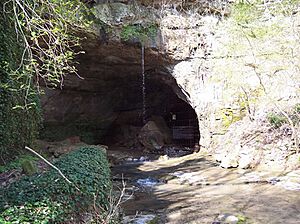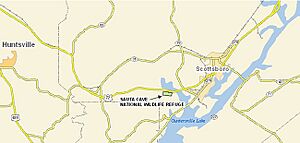Sauta Cave National Wildlife Refuge facts for kids
Quick facts for kids Sauta Cave National Wildlife Refuge |
|
|---|---|
|
IUCN Category IV (Habitat/Species Management Area)
|
|
| Location | Jackson County, Alabama, United States |
| Nearest city | Scottsboro, Alabama |
| Area | 264 acres (107 ha) |
| Established | 1978 |
| Visitors | 5,000 (in 2005) |
| Governing body | U.S. Fish and Wildlife Service |
| Website | Sauta Cave NWR |
Sauta Cave National Wildlife Refuge is a special place in northeastern Alabama. It covers about 264 acres and is a National Wildlife Refuge. This means it's a protected area for wildlife and their homes. The refuge is located near the Sauty Creek area of Guntersville Lake.
About 5,000 people visit the refuge each year. While there are no staff members working directly at Sauta Cave, it is managed by the Wheeler National Wildlife Refuge in Decatur, Alabama. The cave itself is closed to visitors to protect the animals living inside.
Contents
A Look Back: History of Sauta Cave
Sauta Cave has a long and interesting history. It has been used for many different purposes over the years.
Early Uses: Mining for Gunpowder
Long ago, Cherokee Native Americans used the cave. They mined the soil inside to find a substance called saltpeter. Saltpeter was a very important ingredient for making gunpowder.
Mining for saltpeter continued during the War of 1812 and the American Civil War. Sauta Cave was one of the biggest saltpeter mines during the Civil War. You can still see parts of the old mining operations, like a wooden railroad and large iron kettles. The tunnels where the mining happened are now called "The Catacombs."
A Courthouse in a Cave
In 1819, the same year Alabama became a state, Jackson County, Alabama was formed. The county seat, or main town, was Sauta. For a time, court meetings were even held inside Sauta Cave!
From Nightclub to Fallout Shelter
Later, from 1919 to 1956, a building near the cave entrance was a fishing store and a nightclub. People would dance near one of the cave entrances to enjoy the cool air blowing out.
In 1962, a local National Guard unit got the cave ready to be a fallout shelter. This was a safe place where people could go if there was a dangerous event, like a nuclear attack.
Protecting Bats: The Refuge is Born
In 1978, the United States Fish and Wildlife Service bought the land. Their goal was to protect two types of bats that were in danger: the Indiana and gray bats. At first, the site was called the Blowing Wind Cave National Wildlife Refuge. Access to the cave was only allowed for scientists studying the bats. In 1999, its name was changed to Sauta Cave National Wildlife Refuge.
Wildlife at Sauta Cave
Sauta Cave National Wildlife Refuge is a very important home for several endangered species. The main animals it protects are bats.
Endangered Bats and Other Cave Dwellers
The refuge helps protect the gray and Indiana bats. In the summer of 1997, scientists counted over 200,000 gray bats living in the cave!
Other interesting animals also live in the cave. These include the Tennessee cave salamander (Gyrinophilus palleucus), the Rafinesque's big-eared bat (Corynorhinus rafinesquii), and the cave salamander (Eurycea lucifuga).
Rare Plants of the Refuge
Besides animals, the refuge also protects a rare plant. This plant is the federally endangered Price's potato bean.
Visiting Sauta Cave Refuge
There are two entrances to the cave, located on a hillside within the refuge. While you generally can't go inside the cave, scientists are allowed in for research. The refuge offers great chances to watch wildlife, go hiking, and take photos.
Watching the Bat Flight
One of the most exciting things to do at Sauta Cave is to watch the bats leave the cave at dusk during the summer. For about an hour as the sun sets, around 400,000 bats fly out of the cave. They are heading out to find food for the night. There is a special viewing platform built so visitors can easily watch this amazing sight.
Images for kids








